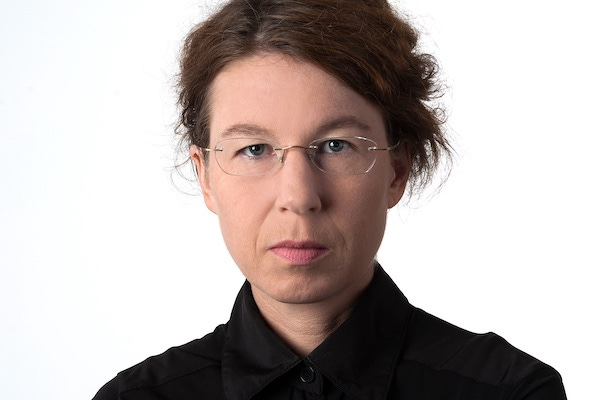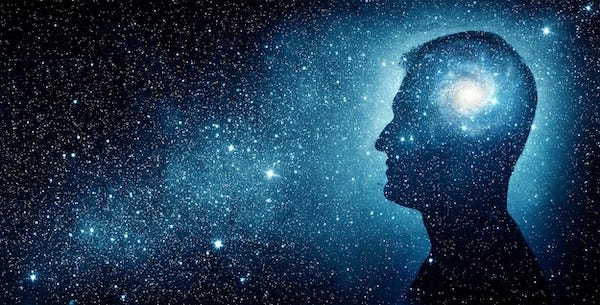I very much doubt the universe thinks
Recent suggestions to the contrary don’t take biology seriously, as usual
Sabine Hossenfelder is a brilliant theoretical physicist with whom I almost always find myself in agreement. Her book Lost in Math: How Beauty Leads Physics Astray is a superb takedown of the recent fashion in fundamental physics to judge the merits of scientific theories on the grounds of non-empirical criteria, such as “beauty” or “elegance.” Which is a really, really bad idea.
Sabine also wrote a no-nonsense rebuttal of a recent pernicious fashion in philosophy, the entirely not empirically verifiable notion of “panpsychism,” the idea that consciousness is, somehow, a basic property of matter.
Occasionally, like the rest of us, Sabine gets something wrong, or at the least she defends a questionable position. So far, I called her only on one such occasion, back in 2020, when she decided to write that predictions in science are “overrated.” This post is my second such call.
She recently published an excerpt from her book, Existential Physics: A Scientist's Guide to Life’s Biggest Questions, in the form of an essay entitled “Maybe the Universe Thinks. Hear Me Out.” I did hear her out, but I ended up not appreciating what she had to say. Let me first summarize her position as fairly as I can manage and then try to explain why I think she is off base and why it matters.
Sabine’s article is based on a technical paper by Italian astrophysicist Franco Vazza and neuroscientist Alberto Feletti, published in 2020 in Frontiers in Physics. Their basic claim is that there are structural similarities between the human brain and the universe at large, which raises the tantalizing possibility that the universe, in a sense, may think.
What does this alleged structural similarities consist of? The idea is that the 200 billion galaxies of the known universe are “connected” by intergalactic filaments of interstellar dust that make the cosmos as a whole “look like” the human connectome, i.e., the web that connects neural cells via axons in the brain of a typical Homo sapiens.
Sabine herself immediately raises a number of serious objections to the notion of a thinking universe, based on obvious disanalogies between the cosmos and the brain. First off, the universe is expanding, and the rate of expansion is increasing. This means that, even if there is some thinking going on, it has to be limited and it will get more and more difficult to sustain.
Second, unlike the human brain, the “connections” between galaxies are only local, and it would take a humongous amount of time for a signal originating in one galaxy to even reach the next one, let along to travel to the other side of the cosmos in a fashion similar to how real brains are rapidly and deeply interconnected at all pertinent spatial scales.
Third, though Sabine doesn’t raise this particular point, brain areas are not just physically “connected.” They actively exchange a variety of very specific electric and chemical signals. Is there something like that in the universe? What are these signals made of? What sort of information do they carry? All sorts of things are “connected,” from the roads on a map to the nodes of the internet. That doesn’t mean they think. Connectivity is necessary, but by far not sufficient to generate thought.
You would think this would be the end of it. Sabine has taken down yet another inane idea originating from within a physical community increasingly detached from both science and reality, as she has done many times before. Mission accomplished. Or not, as it is exactly here that things turn weird and the “hear me out” bit comes in. Okay, so let’s keep going.

One way to overcome some of the problems mentioned above, according to Sabine, is to invoke the concept of non-locality. Empirically, we now know that at the subatomic realm, things can be somehow connected over very long distances, a phenomenon known as entanglement.
But, as Sabine again points out, this raises a whole host of new problems. First, we are not even sure whether locality does or does not remain valid at the subatomic level. Non-locality certainly doesn’t seem to be a thing at the macroscopic level, and galaxies are very macroscopic. Any connection across long distances would have to be so small—she reminds us—that not even elementary particles could get through. So, again, what sort of signals does the “thinking” universe rely on?
Moreover, she goes on, entanglement does not allow for non-local transfer of information. But if the universal brain cannot transfer information, in what sense can it think?
Enter wormholes. No, not the kind that you see featured in your run of the mill episode of Star Trek, but the kind that actual physics predicts might exist. Then again, and I am quoting Sabine directly here, “large wormholes can’t exist in our universe because they would close immediately, what wormholes would do in the quantum realm, no one really knows.”
And here is the bit in her article that is really maddening: “There is absolutely zero evidence that non-local connections exist, or that, if they existed, they’d indeed allow the universe to think. But we cannot rule this possibility out either. Crazy as it sounds, the idea that the universe is intelligent is compatible with all we know so far.”
Then what on earth are we talking about? The majority of Sabine’s writings over and over make the point that if there is no empirical evidence for X then X is not science, and we shouldn’t talk about it as if it were.
“But we cannot rule out X” is a really, really, lame excuse for writing an article, let along a chapter of a book. Lots of things, indeed, infinite things cannot be ruled out and yet we, rightly, don’t give them a single thought. Unicorns, for instance, do not contradict any laws of logic or physics, or even of biology. And yet nobody in his right mind, let alone a thinker as sophisticated as Sabine Hossenfelder, would say “we cannot rule the possibility of unicorns out. Crazy as it sounds, the idea that some horse-like animals with a single horn exist is compatible with all we know so far.”
The idea is not crazy. It’s just irrelevant. Precisely because there is no empirical evidence to back it up. Moreover, there are very good reasons to think that the universe is not thinking outside of those that Sabine herself brought up.
This, seems to me, is yet another case of physicists not taking biology seriously. What do we know about thinking, so far? That it is a characteristic of a small subset of biological systems (we call them “animals”), and only of biological systems. And that it evolved as a result of natural selection in order to enhance the survival and reproduction of those biological systems.
The universe, as far as we can tell, is nothing like a biological system. It does not evolve by natural selection, and the very concepts of survival and reproduction do not make any sense at the cosmic level. (Yes, I know that physicist Lee Smolin has advanced the idea of cosmic natural selection, but I’ve argued that—with all due respect (and I have a lot of it for Smolin)—he literally doesn’t know what he’s talking about.)
Why is Sabine writing this stuff, in such a flagrant departure from everything she has done before? She gives us a hint near the very end of her essay, where she says that she has made a name—for better or for worse (her words) by debunking nonsense physics headlines.
But now she is worried that the public will begin to associate science with skepticism (not her words), with a general attitude of “no, that’s not true.” And that’s bad.
She is certainly right that science (or skepticism, for that matter) is not just about denying crazy-sounding claims. It’s about the awe and thrill of discovery, about entertaining apparently crazy ideas that may (or may not) eventually be confirmed by empirical evidence.
Still, it’s dangerous and ill conceived to say, as she does, that the notion that the universe can think is “not contradicted by evidence … and [that’s a story] that deserve to be told, too.” Why does it deserve to be told, exactly? Why this story, but not panpsychism, or parallel universes, or a number of other empirically unfounded ideas that Sabine has so effectively criticized in the past? Because they are not science, that’s why.
I briefly pointed this out to Sabine on Twitter, and—bizarrely—her response was “so we should ban these ideas?” No, we shouldn’t ban any idea, as far as I am concerned! But is it okay to criticize them and to call out those who advance such ideas if they do so without evidence? I surely hope so, in the name of critical thinking and good science.




Even as idle speculation, I'm not sure why the idea of a thinking or intelligent universe would be appealing. One ironic consequence is that the notion of human rights becomes meaningless - just as, within our own bodies, individual cells don't have rights. If we're all part of a larger thinking entity, then we essentially exist in its service. And if it turns out, for example, that all of Earth's inhabitants need to pass from the scene so that the universe could be 'healthier,' then so be it.
But as you say, this is not a biologically informed concept - and I'm not sure exactly what it's supposed to be!
So anything I want to believe, as long as it hasn't been proved impossible, can be slapped with the "scientifically possible" label and trotted out as something people should seriously consider? Well I guess have to start worrying about Cthulhu now because it's not scientifically impossible that an elder god sleeps in a sunken city in an unexplored part of the ocean and will someday awaken and devour us all. Maybe the universe telepathically sent messages to Lovecraft who just thought he was thinking this stuff up on his own? I mean it's not unscientific now, is it?